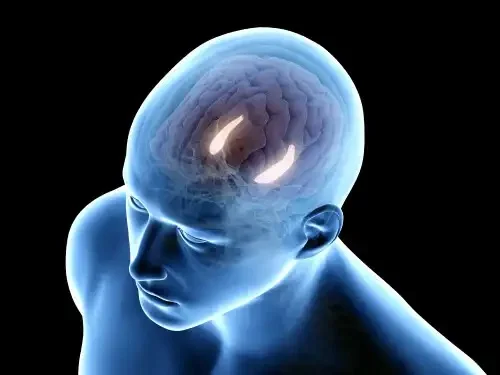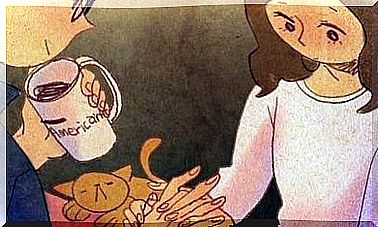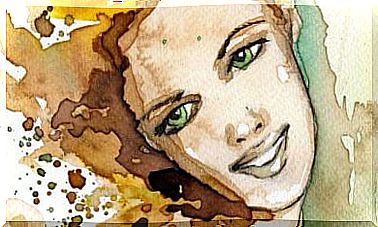Panic Attacks Are Paradoxical

Panic attacks are so common that you probably know someone who has suffered from them – unless it’s you. Therefore, it is important to understand why panic attacks are paradoxical.
Panic attacks are closely related to anxiety, although not all anxiety disorders manifest as panic attacks. When someone gets a panic attack, they feel like they’re dying. This feeling comes suddenly and is very intense. In reality, however, very few, if any, have died of the symptoms caused by a panic attack.
It is therefore interesting to explore the paradox of recurrent panic attacks. Why does a person experience another panic attack if he or she has already had one and he or she did not die? Why is his next panic attack just as serious or even more serious?
A loop of panic attacks
Before talking about the paradox of a panic attack, it is important to understand how they happen. Different explanatory models refer to the idea of a loop between several elements. These can be:
- Physiological or cognitive changes. For example, fear, anger, and frustration. In other words, all the conditions that cause a person excitement.
- Perception of body changes. The sufferer becomes aware of their breathing or heartbeat faster and begins to worry. However, some panic attacks occur without these warning signs.
- Feeling of an external threat. If a person feels threatened, it causes changes in the body that cause fear and anxiety.
When all three of these factors occur, they become a positive loop. For example, a person who has already had a heart attack may be very scared that he or she will have another attack and he or she will start sweating hard. This symptom only disappears when a negative factor emerges, such as sitting down, trying to relax, or using coping strategies.
Panic attacks have primary and secondary symptoms. The primary symptoms are the ones that the seizure gets noticed first. These include choking, dizziness and palpitations. Secondary symptoms occur when a person has interpreted the first symptoms in a negative tone. These include sweating and tremors. They occur because a person believes that something is really going on for him.
Cognitive theory of panic attack
Catastrophic thoughts are inevitable in panic disorder and agoraphobia. A person tends to interpret their bodily feelings negatively.
Because of his negative prejudice, a person tends to find catastrophic meanings in the slightest thing. For example, people who are more prone to panic attacks tend to answer all questions with a catastrophic answer. For example, possible answers to the question “Why is my heart beating so fast?” could be “Because I just saw my girlfriend,” “Because I’m happy,” or “Because I’ve smoked too much,” “Because I have a heart attack”. People with a negative perspective choose the latter option out of these.
The key factor in a catastrophic interpretation is a person’s faith or belief, not the number of symptoms he or she experiences. Thus, even if they experience only one symptom, these people actually believe they are dying and getting a panic attack.
Panic attacks are paradoxical because they don’t go away
If a person is afraid of mice and he is in a state where there are rodents that he can touch and with whom he can play, he understands that animals are not a threat. Therefore, he ceases to fear them. This is called getting used to. It happens in virtually all areas of our lives.
For example, a child stops being afraid of school when he gets used to it and realizes that it doesn’t pose a threat to him at all. Or a man ceases to be afraid to drive a car when he realizes he can drive without having to have an accident.
This is due to exposure. Exposure is a technique that allows a person to become accustomed to a particular stimulus. As a result, he realizes that the catastrophic consequences he expected to happen before he was exposed will not happen.
In the event of panic attacks, he should no longer be intimidated by the feeling of suffocation, dizziness, and palpitations. Because he now knows that these symptoms do not lead to a heart attack. However, this is not always the case.
Some people may suffer from one panic attack and they will never have another in their entire lives. Others, on the other hand, may have more than one seizure, and some may develop panic disorder with weekly or even daily seizures. There are some theories as to why panic attacks occur in a person again.
Equal potential
Depending on the nature of the stimulus, the sufferer may experience more or less fear. Preparatory theory suggests that existing associations have certain fears and phobias, the extinction of which is slower. These are usually biological and acquired through evolution. For example, we are more threatened by fears that can be life-threatening, such as height: because of the risk of falling.
Therefore, eliminating such fears is much more problematic. One example is snakes, for example. Just because a snake doesn’t bite you the first time doesn’t mean another snake won’t bite you in the future. The same is true with a heart attack. It may not happen every time, but there may come a time when symptoms are a real warning sign.
Memories of the hippocampus
According to biochemist P. Quijada, the hippocampus is responsible for associating these dangerous events with memory in memory. This means that when a person experiences a panic attack, it is “stored” on the hippocampus.
As a result, the sufferer of a panic attack usually has memories of how bad he felt during and after the attack. Memories with a lot of emotional content are hard to erase from the mind.

Avoidant behavior that exacerbates the problem
People who suffer from panic attacks try to avoid the situations or stimuli that cause them. However, avoiding these situations exacerbates the problem. Therefore, anxiety leads to avoidance, which in turn leads to anxiety, i.e. the squirrel wheel is born.
Fear of panic attacks
The fact that a perceived threat does not materialize after a scene does not mean that there is nothing to fear. On the contrary, a new panic attack does not confirm to a person that there is no fear, but it does confirm it.
In fact, he notes that a panic attack is almost as dangerous as the heart attack itself. Because even if he doesn’t die, he feels like he’s close to death.
Panic attacks and disorders are unpleasant, but can be treated quickly and effectively. Thanks to psychopedagogical, cognitive rearrangement, behavioral techniques such as relaxation and deep breathing, attentive focusing techniques, and exposure, many never experience a new panic attack.









